6,500 Retirement Fund Signups in 12 months – Growth Strategy
We launched our Growth Marketing service last year with the aim of radically improving our digital marketing services, and for a large number of clients – in a wide range of industries – it’s been a huge success.
With Growth Marketing, clients get assigned a full marketing team from Webprofits (akin to an outsourced marketing team). Teams vary in size but usually include:
- 1x Growth Lead
- 1x CRO Producer (covering CRO, PPC, Email & Design)
- 1x Social Media Producer
- 1x SEO Producer
- 1x Content Producer
This team of talented and conversion-hungry marketers then work together in a pod to maximize the results generated, with outputs optimized and scaled based on priorities and what’s working. No strategy is the same for any one client and what is often planned as an initial three-month strategy rapidly evolves and changes to get the best outcome.
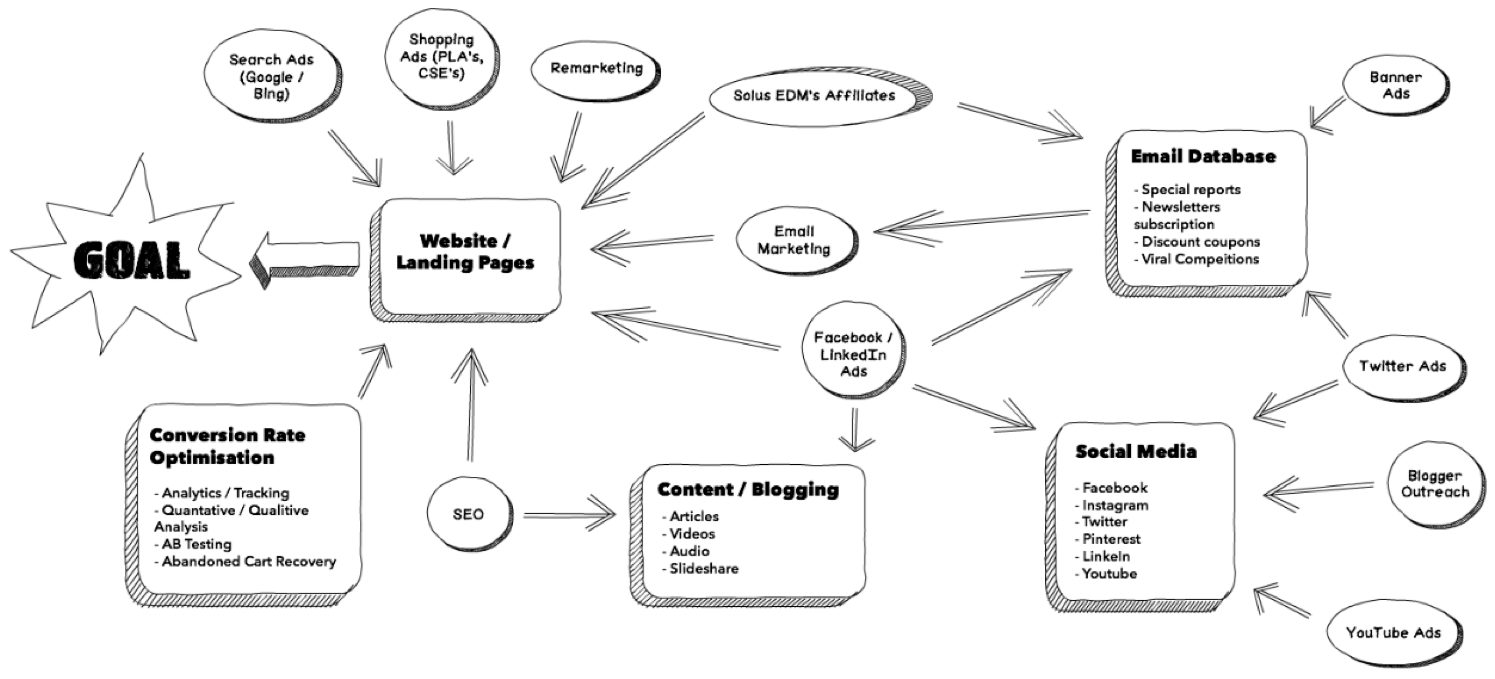
Growth campaigns are pretty fun to work on for the team at Webprofits as we get the freedom to test new networks, channels, and techniques and contribute to the overall success of the campaign – something we’re all driven to do. Our clients also love it as they can reprioritize and adjust outputs based on their own internal goals over time… Plus we’re getting awesome results for their businesses.
Case Study: Retirement Fund Services Company
To give you an idea of how Growth Marketing actually works, I’m going to run you through a campaign we’ve been working on for the past year for a retirement fund services client, who came on board with us in July 2015.
The fund only invests its member’s funds into businesses that align with a very stringent code of ethics – essentially companies that are doing good for the world and refrain from doing harm. They also look for the best investment returns for their members, and they’ve done really well in that regard, with one of their 401(k) options generating a 10-year return of 8.3% (as at 30 June 2016). It’s a very strong product to market, as it aligns well with society’s move towards a more sustainable future (eg. the move to solar over coal), so there’s no doubt that the strong brand and strong offer have helped us achieve success.
For our client, a conversion is someone going through a signup process and actually switching their 401(k) then and there – so it’s a direct sale as opposed to a lead and as such, it’s more valuable, but harder to obtain.
We’ve done a lot for this client as part of the growth package, which I’ll elaborate on soon, but firstly let’s take a look at the results we’ve generated in under a year:
- Over 6,500 401(k) signups generated, beating their goal by 66.4%
- Monthly 401(k) signups increased by 255%
- Funds under management increased by 32.2% from $787.7m (30 June 15) to $1,041m (30 June 16)
- Email database increased by 322% to now over 30,000 prospects
- Facebook Fans increased by 35,573 (now over 90,985)
The monthly growth in 401(k) signups from August last year has been pretty consistent (apart from a dip in December) and just recently they announced very strong results for the year:

So how did we generate such impressive results?
BONUS: Request a free growth session and we’ll develop a digital strategy you can use to drive growth and achieve your goals ($4000 value). Alternatively, empower your marketing team with a free 1 hour growth marketing training session.
How We Achieved The Results
After a detailed scope meeting with our client outlining their brand, their goals and what resources they had that we could leverage, we created an digital marketing strategy that was shaped around building them a “marketing machine.” The plan was designed so that even if they had to shut down advertising for any reason in the future, they’d still generate a significant volume of 401(k) signups month-on-month. The strategy we created had both short-term elements to it (paid traffic, for example) and long-term elements (search engine optimization, for example) – both equally important.
Once the strategy was created, we formed the Growth team at Webprofits to carry it out. The team were selected based on their past experience and unique skills, and included myself as Growth Lead, Ales Pokora (Social), Matthew Siddle (CRO), Sophie McAulay (Content) and Nick Brogden (SEO). We then began to assign tasks and roll them out as quickly as possible.
The tasks we set month-to-month were “fluid,” meaning that if something with a higher priority came up in any month or if one channel was getting amazing results, we could quickly divert resources and marketing spend into those areas to ensure we took advantage of the opportunities when they occurred – a good model for both parties, and more importantly, for results.
It’s important to note that the results we have achieved over the year have been significantly helped by our client themselves, notably:
- They have an excellent, growth-focused internal marketing team who we collaborate with daily, led by their CMO.
- Driven by their Head of Ethics, they’ve built a brand with strong values, which align with those of their target market.
- They have little red tape, fast approvals and are also flexible with their branding – getting everything “perfect” brand-wise doesn’t hold us up from getting great results.
- The product/offer they have is a great one to sell and is in the market at the right time with consumers moving towards more ethical and sustainable consumption.
- They have unlimited ad spend budgets at profitable “cost per signup” levels, meaning we can maximize the volume of signups from each channel while knowing they are making a profit from every dollar spent.
So what type of marketing have we actually built for this client over the past year?
The Marketing
- Pay Per Click
- Social Media
- Email Marketing
- Conversion Rate Optimisation
- Search Engine Optimisation
- Content Marketing
Pay Per Click
Earlier in this case study I mentioned quick wins and in digital marketing, there’s no quicker win than pay per click marketing. In under an hour, you can have your ads live on an ad network and be driving highly qualified traffic to your website or landing page. At Webprofits, we have no allegiance to any pay per click network and just use what works for each client. We’re still exploring new networks currently but here’s what we found worked this year.
Search Engine Marketing (SEM)
SEM, where you place your ads on certain keywords/search terms is one of the biggest online advertising channels around the world, with Google leading the pack. We built highly targeted campaigns for our client, targeting and testing a range of keywords and optimizing them constantly based on the cost per signup and volume of signup metrics, to decrease costs and increase results.

We also launched campaigns on Microsoft Bing’s search engines, an often ignored and forgotten part of the SEM world. While they used to have a less than 5% search share, in July 2018, Microsoft Sites handled 24.2 percent of all search queries in the United States – a significant volume that can’t be ignored. We set up campaigns on Bing using their handy importer where you can literally copy and paste your successful Google Ads campaigns across to their platform. Despite a much more limited volume of signups, there is not much competition on Bing (meaning cost per clicks are lower), so we managed to generate signups at a significantly lower rate than with Google.
Unfortunately, on both Google and Bing, the cost per clicks for 401(k) products are extremely high, with competitors bidding huge amounts, based on long lifetime values. At the high costs, to hit our very low cost per signup goals we would need a 10% conversion rate – something that’s not likely with an actual online signup. This counted out a large part of the search volume that we had to work with, so we had to get creative and find a range of ways to target ads that didn’t have as high a cost per click.
An example of this is a competitor campaign we built targeting the number one 401(k) fund. We placed ads on a wide range of keywords containing their brand name and then drove the traffic to a specifically built comparison page where prospects can see for themselves which super option they should select.

The end result? Much cheaper cost per signups than if we had just bid on “401(k)” keywords like everyone else. This example is just one of a number of campaigns we have built out, which are proving successful.
Display Advertising
Banner adverts were the first ever type of digital marketing. This is an area that, while harder than search and more expensive on a cost per conversion basis (usually), still has a lot of potential volume-wise (once you’ve exhausted how much you can spend on SEM).
In our view, the keyword, interest and demographic targeting that’s available for Google Display campaigns isn’t good enough to use (even with targeting, ads often appear on Justin Bieber meme sites). So we stuck purely to placing ads on specific sites that we chose as high quality. To do this, we used a range of tools and built a large list of websites that our client’s target market were likely to be using, and then created campaigns targeting these specific placements on the Google Display Network.
It’s important to note that all optimization work utilized direct, click-based conversion data. We find that view-through or impression-based conversions (where someone was served your ad and possibly saw it, didn’t click it but later converted) are not reliable indicators of what made someone convert and thus choose not to report on them or optimize based on them
Remarketing
Remarketing is where you target a past website visitor with banner or text ads to entice them back to your website to convert. When our client first came on board they were with AdRoll, a third party retargeting company that optimizes your ads automatically for you. Upon auditing the results, we found they were getting next to no direct conversions, so we quickly stopped the ads.
Instead, we set up individual campaigns on channels directly – such as Google’s Display Network or Facebook – so that we could control the optimization of the ads manually. We ensured that everyone who did complete the signup with our client were instantly removed from the remarketing pool. We also set up tagging on the login page of their website to exclude current members, and utilized a feature from both Google and Facebook where you can upload a database of email addresses (in this case, their current customers) and include or exclude them from a campaign.
We divided the remaining audiences up based on the number of days it had been since they visited the website, with past experience showing us that the sooner we remarketed to them, the more likely they were to convert. We bid accordingly on each of these day-based audiences and optimized to achieve the highest volume of signups possible, at or below the target cost per signup.

Gmail Sponsored Promotions (GSPs)
Another area of the Google advertising platform we explored and ran ads on successfully was GSPs. These ads are exclusive to Gmail’s email platform, and on both desktop and mobile devices appear as if they are emails within the person’s inbox. When clicked, they reveal a large image, a headline, copy and a call-to-action button.
The best part about this type of advertisement is the targeting; essentially you can target users based on who is emailing them. So, for example, we added a target to the campaign of “greenpeace.org”, which meant that our advert showed in the inbox of people who had recently received an email from Greenpeace. We targeted both the subscribers of large, ethical organizations and also every other 401(k) company we could find that were likely emailing their members regularly.
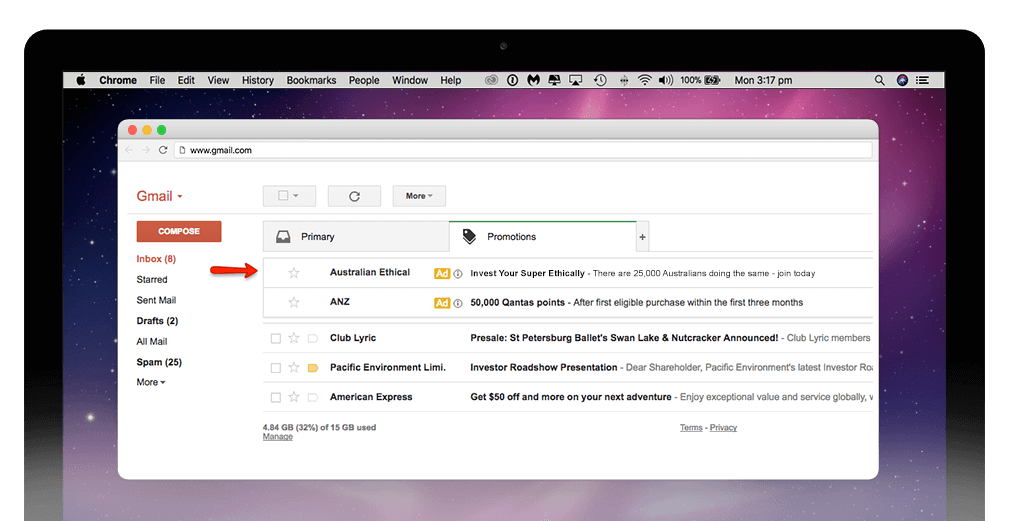
YouTube Advertising
Google has been pushing YouTube Advertising pretty hard over the past few years, and given YouTube’s traffic volumes and potential audience size, we decided to try some conversion-focused video ads on the platform. The issue? We didn’t have any videos to work with that were relevant.
Rather than spending 3-4 months and a lot of money building videos that may not work, we utilised a service called Veeroll, which allows you to create your own videos in minutes using their templates. Whilst from a branding point of view, these videos may not be exactly right, it enabled us to rapidly test what we could achieve on Youtube.
What we found from testing a wide range of audiences, including remarketing, is that we could get sign ups direct from YouTube (you can add trackable links in your video ads directly to your website) but not at a cost per signup that made sense for us to spend budget there as opposed to other channels, so we quickly brought the campaigns to a close. The network, however, did show promise, so now we are spending time with our client to create some higher quality videos to re-test and hopefully generate a meaningful volume of direct conversions at the right cost.

Social Media
Any brand that wants rapid growth cannot rely on search alone. Eventually you max out the traffic you can generate due to the volume of searches, and can no longer increase conversions. Social media, however, offers a huge audience of passive prospects, with more than 200 million on Facebook in the U.S. alone. Over the past few years social media has now moved from a “brand building and engagement” platform to one that can generate meaningful conversions so this is an area we spent a lot of focus on for our retirement services client.
Our client was already active on Facebook so we took what they were already doing and using a conversion-focused approach, we optimized, improved and scaled the campaigns with the cost per signups and volume close to what we generated from our pay per click campaigns by the end of the year.
Conversion-Focused Ads
With a focus on 401(k) signups, we started with ads directing people to a landing page that explained why they should switch to our client’s retirement fundl, and pushed them into a two step process to do it then and there. We measured both step one and step two, but our conversion pixels only triggered on completion of the signup to ensure we were optimizing for the actual signup. Over the year, we trialled targeting a number of audiences for these ads, including:
- Remarketing (Sitewide & Abandoned Signups)
- Fans of our client’s Facebook page
- Current Member Lookalike Audiences (1% & 2% Similar)
- Interests: Pollution, Sustainability, Renewable Energy, Environmental Movies (Black Fish etc), Climate Council, Recycling, Sea Shepherd etc.
The most effective audience was remarketing, closely followed by lookalike audiences (an audience whose demographics, interests and other factors closely match an audience you define). In this case, we uploaded all of our client’s current members and then targeted lookalike audiences of them, as well as creating lookalikes of every other audience we had success with.
We created a range of ads with a creative spin to them all, with our most successful being one of our simplest approaches:

Yes – you saw that correctly, our advert was shared an incredible 2,083 times and liked over 16,000 times. This generated free organic traffic to the website via the friends of everyone engaging with the ad, as well as a lot of signups. This is one of the advantages to marketing a brand people align with and are passionate about. We frequently updated and changed the ads (as the click through rate dropped off when the ads became stale) and tried both photo and graphical images.

Email Acquisition Ads
Along with generating direct conversions, social media is also a great way to push offers with less commitment required, such as an email capture. If the offer is good, a passive audience who is not looking for products or services then and there will respond at a far higher rate than to the straight conversion-focused campaigns – resulting in a cheaper cost per conversion. For our client, we ran two types of email acquisition campaigns, and only launched them after we had created automated email sequences upselling switching to our client – very important to have in place prior to launching these campaigns (more on the email marketing strategy below).
Free Downloads
The first type of email acquisition campaign promoted content that had been created and turned into eBooks or PDF downloads, and that appealed to their target market. The ads sent users to a landing page that let them download the resource for free by entering their email address:

Again we generated a significant number of shares and likes on the advertisement, lowering our “cost per email”, which we monitored closely with a target of just a few dollars per email address collected.
Competitions
The second type of email acquisition campaign was viral competitions. With competitions, it’s important that the prize only appeals to your target market. But with everyone in the US having a 401(k) account and the Great Barrier reef under threat, we launched a competition and promoted it across our social channels:

Instead of asking people to “comment to win” or similar, we sent them to a landing page which had inbuilt viral functionality. As soon as people entered, they were then encouraged to share the competition on their own social accounts to receive 3 extra entries for every person who entered from their link – something that worked really well.

Overall these campaigns generated over 30,000 email prospects in the database, who are now in the process of being converted into customers.
Creative Campaigns
Although we are a predominantly conversion-focused agency we still like to be creative. Throughout the year, we ran a number of creative social campaigns, firstly posting the content organically and then amplifying the content that generated the most engagement with ads. An example of a style of content that worked the best was fact-based creative imagery:

This content generated a lot of engagement in the form of likes and shares, which then led to an increase in new fans (one of our top targets for conversion-focused ads):
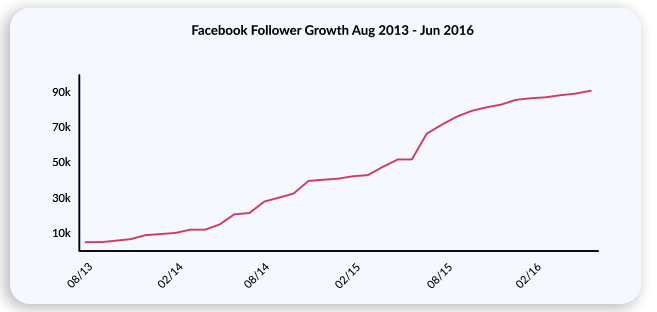
The real benefit of this increase in fans and engagement? Conversions. As you can see below, we had a small conversion-focus with the content we shared socially, which was seen by fans of the page and the friends of the people who engaged with the content – leading to a growing number of sign ups monthly:

Along with creative imagery and campaigns, we also made sure to share all of the content we published on our client’s blog across social media, with ad campaigns helping to amplify the most successful content. Everyone who then clicked-through to read the article were added to our remarketing pool to target with later conversion-focused ads. With the content being of high quality, many were also likely to subscribe (and get our email sequences) or signup direct after reading the articles:

Community Management
A major concern from bigger brands about advertising on social media is fielding negative feedback and comments from “trolls.” While this is a legitimate concern, with the right strategy, the negative feedback can be turned around in a way that will influence others who view the interaction. Hats off to our client’s internal team for handling the community management side of things with an unparalleled amount of effort being put into responding to each and every comment and question. This has helped our overall results and the building of a transparent and open brand which consumers, especially in this target market appreciate.
Instagram’s self-service ad platform launched around a year ago and since then we have been experimenting with strategies to generate conversions. Advertising works the same as on Facebook, by targeting audiences; a bonus being that you can also target audiences you have already built on the Facebook ad platform. With almost all users on Instagram using a mobile device, succeeding requires a high mobile conversion rate.
Through the year, we tested a range of ads and audiences on this network, along with posting all of the creative campaign content. Likely due to the complexity of switching your 401(k) then and there on a long form while on your mobile device, we found that the conversion-focused ads were not able to generate a high enough volume of cost-effective signups. While a cross-device attribution model would likely show a number of users signing up later on a different device, we instead switched tact to focus on email acquisition ads – a much easier conversion for a mobile user to complete and one where the cost per acquisition compared closely with Facebook.

Looking for other profitable channels to expand our marketing to we also trialled a small test advertising budget on Twitter. We targeted a range of different audiences including:
- Remarketing
- Followers of Ethical/Green/Charity brands & influencers
- Interests / Hashtags
We created a range of different ads including ones which targeted events that promoted sustainability and ethical practices (such as Earth Hour). Ultimately the remarketing audience performed best, but despite generating a significant volume of targeted traffic, we could not generate enough signups at a cost-effective level to continue spending money with Twitter – though it may be something we try again in the future.

Email Marketing
When our client first came on board with us, they were doing little email marketing but had just signed up for Hubspot, which in my view is the number one email marketing system for small businesses. We were excited; we had a blank slate, an awesome system to work with and a brand that had a target market who are very interested in content. In less than a year, we quickly took their email marketing from generating no sign ups to delivering over 100 401(k) sign ups a month at the end of the financial year.
The email strategy we used is different from most agencies and businesses in that instead of sending out sales-focused and promotional emails all the time, we instead focused predominantly on sending out useful and interesting content, educating prospects and proving to them that our client are the go-to business when it comes to retirement investing.
To create an email marketing strategy, we first looked at where we could capture email signups from:
- Incomplete 401(k) Applications
- Viral Competition Entrants
- eBook/Guide Downloads
- Blog Subscribers
We then started mapping the type of content and emails that each audience should receive with the diagram evolving as we added new email capture sources and as we extended email sequences:
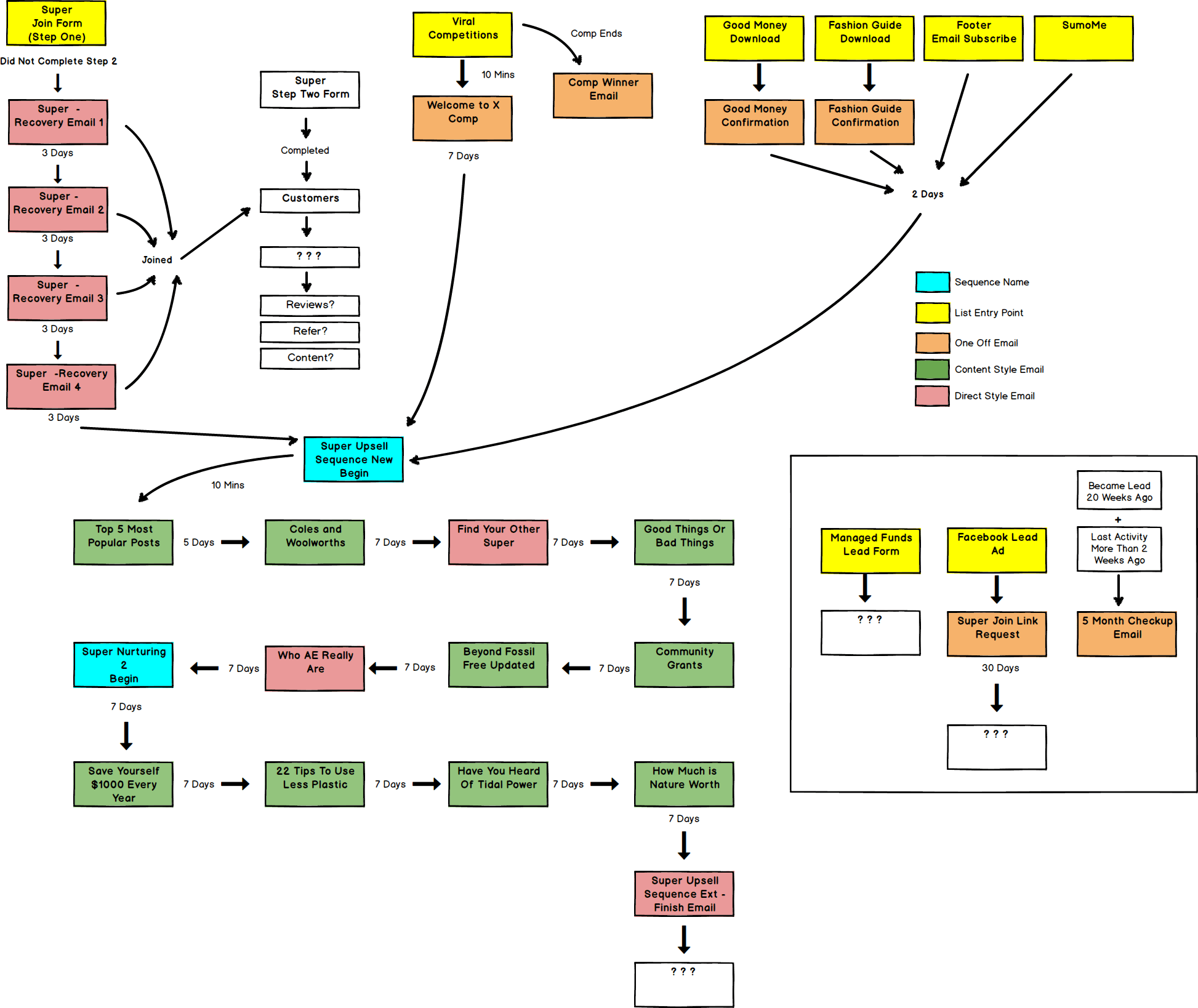
With the plan in place, we then had our team of external sales copywriters write the copy for every email, created templates, and went about setting up automated sequences in Hubspot, ensuring people who we converted were removed from the sequences.

The emails themselves were purposely quite basic in terms of design, and that’s because we wanted the number one focus to be on the content in every email. One sequence we set up was an abandoned cart-style campaign where we aimed to recover everyone who filled out step one of the form, but failed to complete the full signup. This sequence was very important given how hard long forms are to fill out on mobile devices, and allowed people to come back and complete the full signup later. We kept the emails very simple and personal, from an actual member of our client’s staff (but automated) and personalised the links to shortcut the prospect to step 2 of the signup process:

Another example of the emails in our sequences is the content-based email, which pushed people to blog content. Again, we used a very simple template, with the content the main focus.
With email acquisition going well and over 30,000 prospects generated over the year, we sent a lot of emails. The best part was that after the initial setup of the sequences, these were all automated, with the ROI growing rapidly over time and no scrambling to get a last minute newsletter sent out (which can only be used once).
Conversion Rate Optimisation
Improving the conversion rate of a website or landing page is the number one way you can significantly and rapidly increase the number of conversions being generated, because of the effect it has on all marketing channels. Having the highest conversion rate also allows you to spend more on marketing than your competitors (as every click results in that much more), which leads to higher volumes and therefore market share. For that reason, optimizing and improving our client’s website has been a priority for the campaign, starting with gathering data and then moving onto implementation and split testing of ideas.
Gathering Data
There are two types of data you can gather from your current website users – quantitative data and qualitative data. We utilized a range of methods to gather this data:
- Google Analytics
- Scroll & Click Tracking (Heatmaps)
- Form Analytics
- Visitor Recordings
- Polls & Surveys
This data was then used to improve the marketing work we are doing. For example, we ran a survey on the login page and asked members what it was that made them invest their super with Australian Ethical. Contrary to our initial thoughts, the data suggested that being green/sustainable/fossil-free were the major reasons that people signed up (vs being ethical), which has led to us updating marketing, copy and also creating a new landing page focusing purely on this feature of the 401(k) fund.
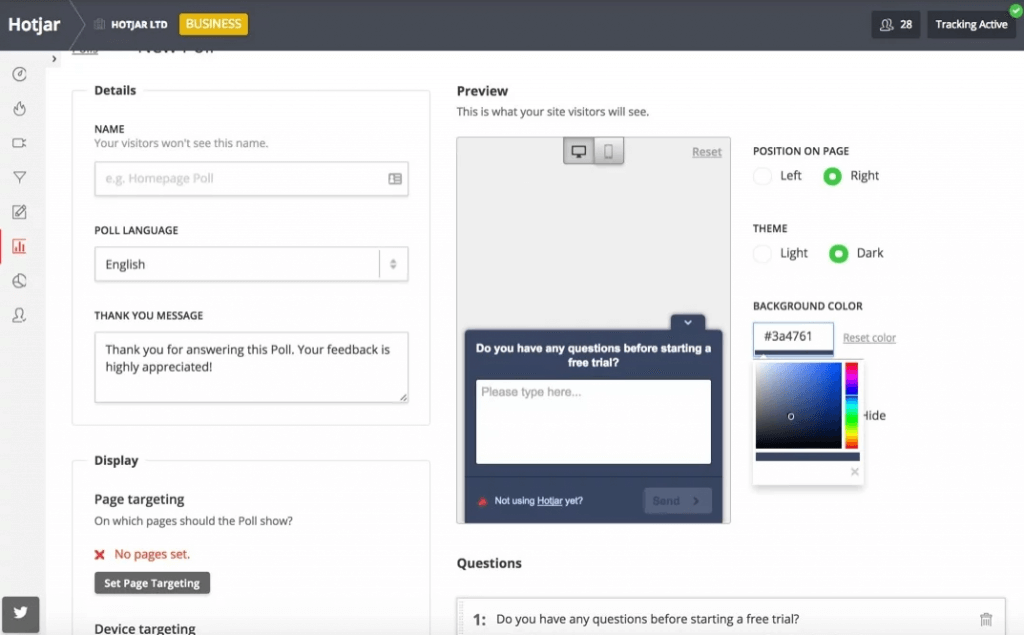
Given the long and complicated signup form, we also utilized screen recording where we can watch replays of people using the website (on 4x speed). We fine tuned this data to specifically find people who spent a lot of time on the form, but never completed it. Access to the recordings was passed to our client’s developers, who are now constantly improving and updating the signup process.
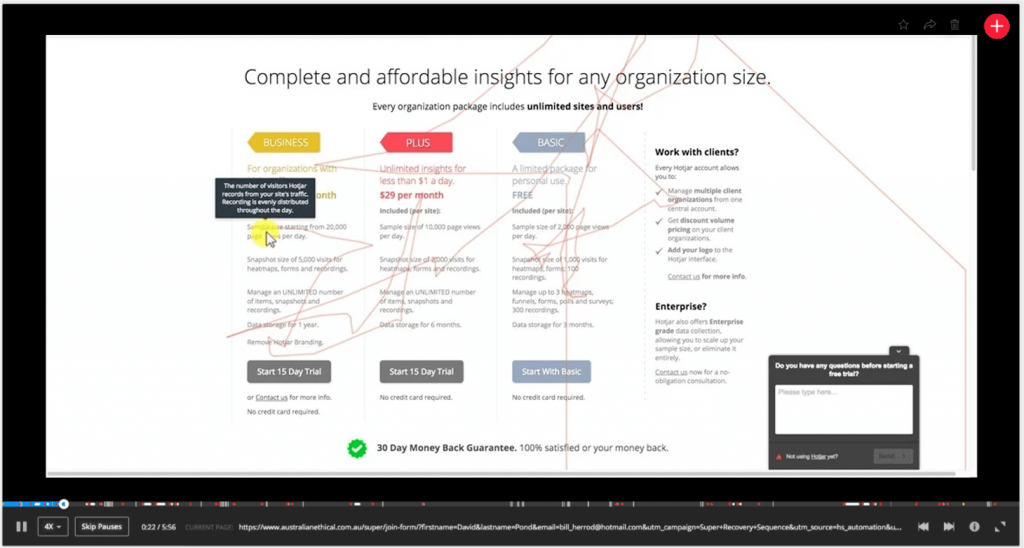
Split Testing
The data we gathered also led to split testing of both the website and specific landing pages that we created, with conversion tracking setup for step two of the form and those successfully completing signup. We declared split test winners from actual membership signups however if a new version of the page didn’t impact signups but significantly increased the people moving through to step two, we went with that version, as our autoresponder sequence to recover lost signups worked very well.

Website Optimisation
Conversion Rate optimization is about a lot more than split testing and making gradual improvements to a website, and so we also looked for growth hacking-style techniques to improve the overall results of our client’s marketing campaigns. Two examples of this were a referral program and exit detection popups.
Referral Program
In conjunction with our client, we created a referral program for current members, to receive a $25 voucher for every member they referred. We then updated the thanks page after a successful super signup to encourage this sharing – giving each person unique links for them to share on social media or via email.
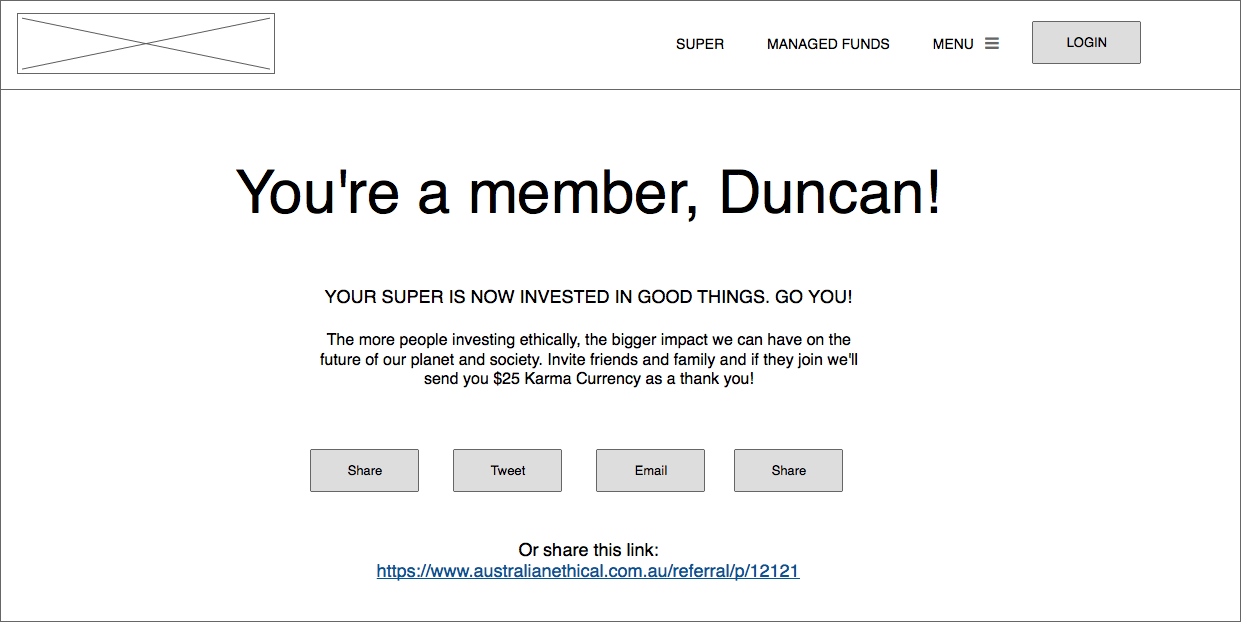
This small change to the thanks page has led to around 20 new 401(k) signups per month now being generated from referrals, as well as a lot of organic brand exposure. We’ve now decided to turn it into a members email marketing campaign to increase signups further.

Exit Detection Popups
Another example of website optimization work we implemented was Exit Detection popups. These were implemented across the website, blog and landing pages, and were set to trigger automatically if they detected the person was about to leave (determined by mouse movements). The popups were tracked separately and in one month alone assisted with over 50 of the conversions generated.

Search Engine Optimisation
Along with concentrating on the short-term and trying to generate as many conversions as possible, with Growth Marketing campaigns we also look to build long-term success with outputs such as the autoresponder email sequences mentioned earlier setup to last years. Another longer term strategy we utilized is search engine optimization, which over the past few years has changed considerably. It’s now no longer possible to target specific keywords and rank for them quickly, so we employ longer-term, white-hat strategies that over time will increase organic traffic and thus conversions.
Onsite Optimisation
The first place to start with any SEO campaign is with onsite work, and after a thorough audit of how our client’s website was setup and optimized, we began to implement a range of best practice techniques. These included extensive keyword research and the updating of all title and meta tags throughout the website. With the initial list checked off, we then began looking at what more we can do – for example, implementing schema markup on the website to push ratings and reviews into the organic search results, increasing the click through rate whenever their pages appeared.
Offsite Link Building
The second part of an SEO campaign is offsite link building, with links still playing a very big part in where a website ranks. For our client, this started with competitor audits of the sites that are ranking in the top positions on the keywords we want to target, to work out exactly what strategies they are using to obtain their ranking (something that’s different in every industry). We reviewed competitor’s websites and blogs and thoroughly analysed every backlink they had.

At the end of these audits, we had a huge list of “target” high-quality backlinks, which we knew would increase rankings for our client if they could acquire them as well. So using a variety of tactics, we built as many of those links as possible through the year. We also utilized large internal lists of backlink targets which we have created over years of performing SEO for companies around Australia and that we knew would have a positive impact.
To build further links we also made sure to utilise every content piece we wrote, with outreach to everyone we mentioned in articles. This frequently led to links to the content piece and sharing across social media channels.
As part of the SEO strategy, we also looked at ways we could increase the number of links to the site utilizing current partnerships, including current customers, grant recipients, and companies our client invests in. One of these strategies which is currently being rolled out is a badge to be placed on the websites of companies who choose our client as the default fund for their employees.
Content Marketing
When our client initially came on board, one of the things they were doing a great job of was content marketing. A blog, which they named “Good Money Blog,” was already in place, with regular content that appealed to the target market being written and shared. The strategies we employed looked to expand what they were already doing, generate more conversions on the blog and take things to the next level.

Blog Articles
It’s tempting with writing blog content to presume what the target market wants to hear about and get started on writing straight away. However, we use a different, data-driven approach to content to ensure we are writing the best possible content to generate links, social sharing and ultimately traffic & conversions. Along with using Google’s Keyword Planner to check that topics have a high enough volume of traffic to be worthwhile writing about, we also used a number of tools to conduct audits on competitors and industry blogs. We then quickly built a list of topics that are commonly shared and linked to in the industry and were able to work out which ones we could adapt and write better versions of.
Using our team of content writers we then generated monthly content which was posted, shared socially, emailed, and promoted through outreach. Some of the different styles of content included:
- Aggregators,
- Video Transcription,
- Case Studies
- In-depth Articles
- Lists, i.e. 13 countries that give us hope for a green future

Blog Optimization
To ensure we got the most out of every piece of content we produced, we optimized the blog to capture email signups, which then went into our autoresponder sequences and were upsold to joining our client. To do this, we utilized Sumo’s suite of tools, including a Smart Bar, Scroll Box and Popup with messages and offers that we split tested and improved over time.
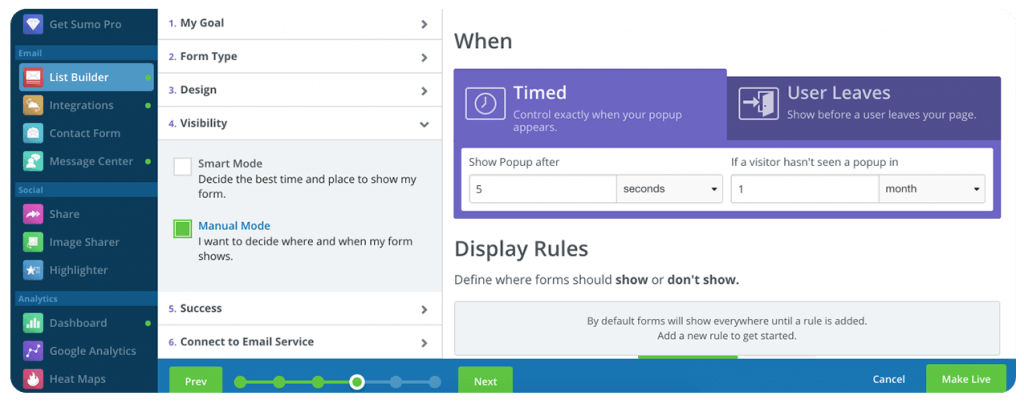
Content Upgrades
With content working extremely well for our client and a range of interesting topics that can be written and expanded on, we also worked on a range of content upgrades, such as eBooks to go alongside the “Good Money” magazine which is produced in-house every quarter. We utilized these content upgrades to improve the conversion rate of the Sumo tools in place on the blog (everyone likes something free), and to promote via landing pages on Facebook, Instagram, and through remarketing on the Google Display network. We also identified similar blog articles to the eBook content and offered the eBook as an upgrade or add-on to the article they were reading:

Everyone who downloaded an eBook was pushed through an autoresponder sequence of other similar content and remarketed to with conversion-focused ads across all channels.
BONUS: Request a free growth session and we’ll develop a digital strategy you can use to drive growth and achieve your goals ($4000 value). Alternatively, empower your marketing team with a free 1 hour growth marketing training session.
What’s Next?
It’s been a busy year working with our client and the outputs above are just some of what we’ve achieved. Still, the Growth team all feel like we’re only just getting started, and now that we’ve set up a huge range of marketing campaigns we’ve got a great base to roll out a lot of other exciting future strategies and outputs, which we won’t disclose until they’re old news. Results are continuing to impress, with August’s result a record one and so far the team are on track to hit and hopefully exceed the financial year’s targets.
Can We Do It For You?
If you’re a growth-focused business that can work with us as a partner to rapidly implement and scale marketing campaigns, and you already have a profitable product or service that stands out in the marketplace, then you’d be a good fit for Growth Marketing and we can definitely help you succeed online and beat your competition. As part of the Growth Marketing approach, you get a smart, driven team of performance-focused online marketers, who will create a custom strategy and then roll it out. If that sounds exciting, click here to get in touch.





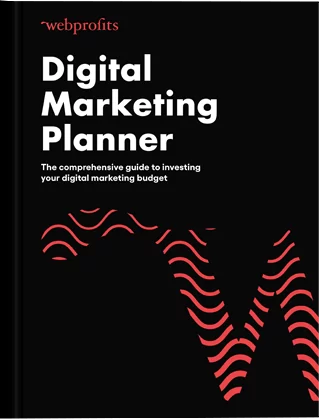
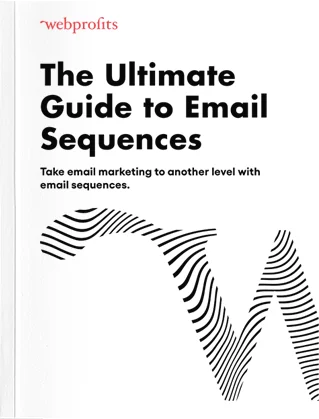
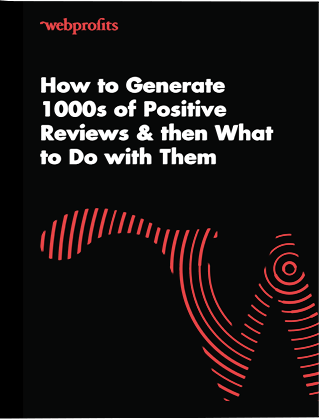
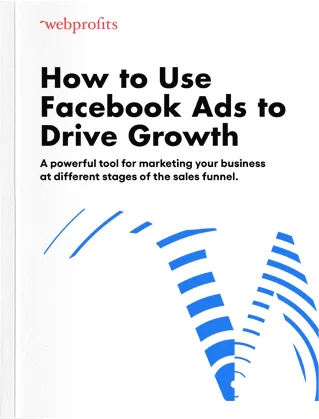
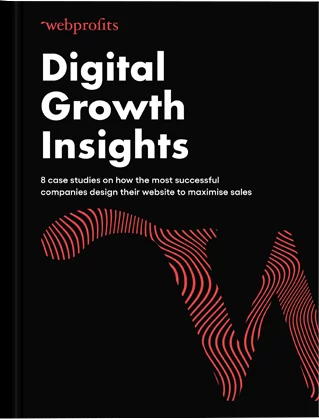
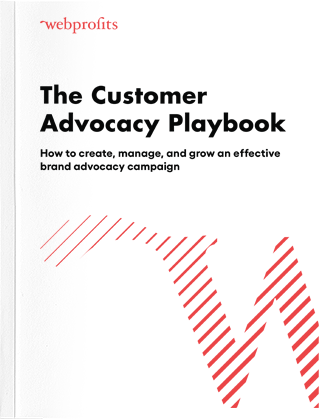
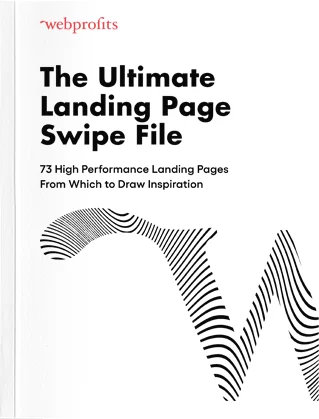

Hi Duncan
Great article. My favourite since the Iconic Review.
You mention above Hubspot is your go to email marketing system for small business. What do you recommend for medium businesses and at what point would a business grow out of Hubspot? I’d love your opinion on platforms like Marketo and Pardot if you’ve used them. I’ve searched online but because they are so good at creating tailored landing pages (after all thats what they do) its hard to know which reviews/websites have unbiased and trustworthy reviews.
Thanks again Duncan. Keep up the amazing work!
Hey Laura,
Great to hear you enjoyed the article!
I would recommend Hubspot for both small and medium size businesses – its pretty scalable and unless you’re sending millions of emails with very specific requirements it should be fine. I’ve recently started using ActiveCampaign as well which is also a good option and has some great integrations and features with things like ‘triggers’ easy to setup.
As far as what enterprise email software you should use once you get to that stage – it really depends on what your requirements are. Generally for large accounts, high deliverability rates and powerful API/integrations will be the most important. You could even use a combination of providers to get the best results using a service such as Ongage: https://www.ongage.com/our-technology/. Of the two you’ve mentioned I’ve used Pardot before and I’m not a fan.
Thanks,
– Duncan
Thank you for the detailed response!
I will take a look at ActiveCampaign and Ongage.
Why are you not a fan of Pardot?
Thanks again Duncan!
Ps. If you wrote an article comparing marketing automation platforms I would definitely share it. I think it is going to be a popular topic of conversation for marketers.
A CRM/Marketing Automation article is on my list to write about – keep an eye on your inbox!
Pardot I find hard to use with a lot of features missing (ie. auto tagging all links with utm tags is a very simple one you think would be included) and ultimately it feels like its built for big corporates as opposed to nimble conversion-focused startups.
Thanks,
– Duncan
Can’t wait and will do. Look forward to it!